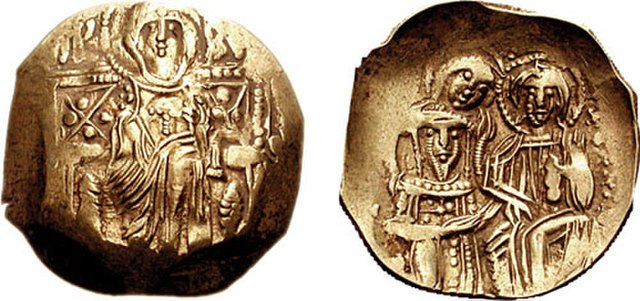The House of Laskaris, Latinized as Lascaris, was a Byzantine Greek noble family which rose to prominence during the late Byzantine period. The members of the family formed the ruling dynasty of the Empire of Nicaea, a Byzantine rump state that existed from the 1204 sack of Constantinople by the Fourth Crusade until the restoration of the Empire under the Palaeologan dynasty in 1261.
Hyperpyron of Theodore II Lascaris (r. 1254–1258)
Arms of Lascaris di Ventimiglia at the Palais Lascaris, Nice, France
The Empire of Nicaea or the Nicene Empire was the largest of the three Byzantine Greek rump states founded by the aristocracy of the Byzantine Empire that fled when Constantinople was occupied by Western European and Venetian armed forces during the Fourth Crusade, a military event known as the Sack of Constantinople. Like the other Byzantine rump states that formed due to the 1204 fracturing of the empire, such as the Empire of Trebizond and the Despotate of Epirus, it was a continuation of the eastern half of the Roman Empire that survived well into the medieval period. A fourth state, known in historiography as the Latin Empire, was established by an army of Crusaders and the Republic of Venice after the capture of Constantinople and the surrounding environs.
Nicaea city wall, Lefke gate; Iznik, Turkey
Coin issued by Michael VIII Palaeologus to celebrate the liberation of Constantinople from the Latin army, and the restoration of the Byzantine Empire.




